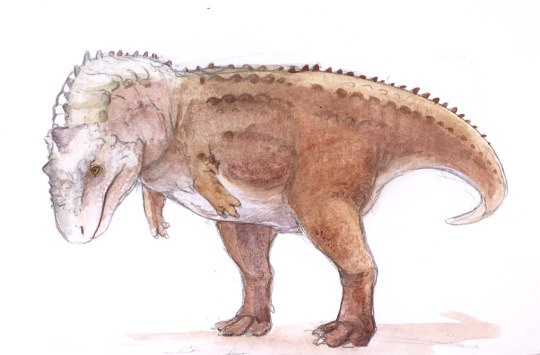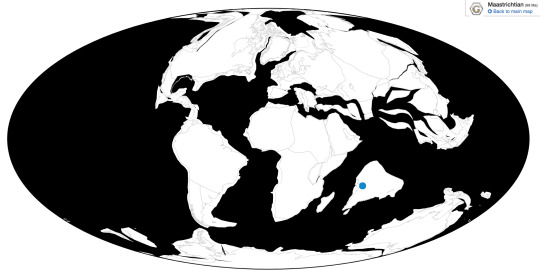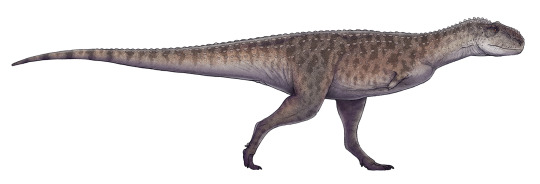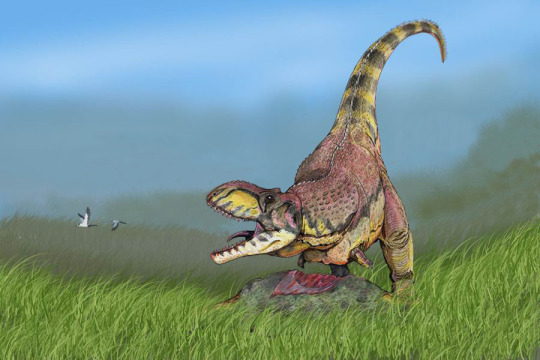#carlo f de filippis
Text
Rajasaurus narmadensis

By Ripley Cook
Etymology: King Reptile
First Described By: Wilson et al., 2003
Classification: Dinosauromorpha, Dinosauriformes, Dracohors, Dinosauria, Saurischia, Eusaurischia, Theropoda, Neotheropoda, Averostra, Ceratosauria, Neoceratosauria, Abelisauroidea, Abelisauridae, Majungasaurinae
Status: Extinct
Time and Place: Between 70 and 66 million years ago, in the Maastrichtian of the Late Cretaceous


Rajasaurus is known from the Lameta Formation of Gujarat, India

Physical Description: Rajasaurus was an Abelisaur - so, a kind of theropod with a long body, almost nonexistent arms, and thick, powerful legs. Rajasaurus in particular differed from other Abelisaurs in having particularly short legs, making it even more… sausage-like… in appearance than even its close relatives. It had a boxy head and thick neck, which would allow it to have a very powerful bite and strength in the neck to hold down prey. It had a strong sense of smell, as well, to help it to find prey from farther away - allowing it to set up an ambush for said prey when it got too close. It had horns on its forehead, made of bone from the nose, which was probably not extended by skin. It was also a lot shorter than other Abelisaurids - which means that it was only about 7 or so meters long, and maybe only two meters tall, if that. It really wouldn’t have stood much taller than an adult man. Rajasaurus had an especially short neck, which may have allowed it to grab onto prey even tighter than other Abelisaurids. It had very short, four-fingered hands, with claws on the first three of them. Though the legs of Rajasaurus are short, it did have very robust, thick toes, giving it more support on the ground. As an Abelisaurid, Rajasaurus was covered in scales all over its body, with potentially round bumpy bits of bone (osteoderms) interspersed among the scales.

By Paleocolour, CC BY-SA 3.0
Diet: As a large Abelisaurid, Rajasaurus would have primarily fed upon larger herbivores, such as Titanosaurs.
Behavior: Abelisaurs were not the fastest animals - after all, if they ran too quicky, they wouldn’t have been very balanced - but what they were extremely agile turners. Being able to turn very quickly allowed them to be efficient ambush predators. Rajasaurus would have waited for prey to appear, and then charged - seemingly out of nowhere, by turning rapidly towards the prey - and then grabbing down onto the struggling prey with its strong, boxy jaws. Though Rajasaurus had small arms and hands, it traded those off for having a stronger neck - to better hold the prey steady with. Then, the stress would weaken the animal, along with blood loss. The horns on the head of Rajasaurus were probably for display and interaction between members of the species, with fights occurring to argue over carcasses or for mates via head-butting or neck-bashing. The horns would have also packed quite a bit of a cutting edge in these fights. It’s also possible that bright colors could have been used on the horns to display. While it doesn’t seem likely that Rajasaurus was particularly social, it did probably take care of its young, and may have formed small family groups while they grew up, in order to protect the young from the many other predators around.

By ДиБгд, CC BY-SA 3.0
Ecosystem: The Lameta Formation is a fascinating Late Cretaceous environment due to the fact that it was a grassland! Grasses evolved sometime in the Cretaceous period. While they did not spread rapidly until the Cenozoic, they did seem to be present in quite a few areas during the Cretaceous (to the point of some hadrosaur relatives evolving to eat them). India at the time was an isolated island, so grasses were able to thrive and diversify more there than in other locations where they did not gain as immediate of a foothold. There was a large amount of volcanic activity nearby, which probably added to its extensive biodiversity (before it made many of the animals present go extinct, via the explosion of the Deccan Traps). It was a lush environment filled with grasses resembling modern rice, flowers, algae, and ferns. This was an environment filled with many lakes, surrounded by extensive mud that lead to its fossil preservation. Rajasaurus was certainly not the only dinosaur of this environment, either! There were even other Abelisaurids - Indosaurus, Indosuchus, Rahiolisaurus, Lametasaurus, and their close relatives the (potentially piscivorous) Noasaurids such as Ornithomimoides, Laevisuchus, and Dryptosauroides. There were also other theropods, probably also Ceratosaurs - Jubbulpuria, Coeluroides, and Orthogoniosaurus. With all of these predators and fishermen, it makes sense that there were a lot of large herbivores for them to feed upon! And there seem to be at least three different kinds of titanosaurs there - Titanosaurus, a dubiously known one; Jainosaurus, a slightly better known one; and Isisaurus, the best known one that seems to be one of the main features of the environment. There was also potentially an ankylosaur - Brachypodosaurus! As for non-dinosaurs, there were large snakes, Sanajeh and Madtsoia; a variety of turtles; and some Dyrosaurid crocodylomorphs!

By José Carlos Cortés
Other: Rajasaurus was one of the Majungasaurines, which had longer holes in their snouts in front of their eyes than their close relatives the Carnotaurines - aka, they had lighter skulls - and having small crests widening the front of their heads; and, in general, longer snouts. This group of Abelisuarids underwent extensive island hopping, reaching places like India via rafting and other journeys across the ocean. Rajasaurus, being one of them, had ancestors that underwent such a journey!
~ By Meig Dickson
Sources Under the Cut
Brookfield, M. E.; Sanhi, A. (1987). "Palaeoenvironments of the Lameta beds (late Cretaceous) at Jabalpur, Madhya Pradesh, India: Soils and biotas of a semi-arid alluvial plain". Cretaceous Research. 8 (1): 1–14.
Carrano, M. T.; Sampson, S. D. (2008). "The phylogeny of Ceratosauria" (PDF). Journal of Systematic Palaeontology. 6 (2): 183–236.
Cau, A., F. M. Dalla Vecchia, and M. Fabbri. 2012. Evidence of a new carcharodontosaurid from the Upper Cretaceous of Morocco. Acta Palaeontologica Polonica 57(3):661-665
Delcourt, R. (2018). "Ceratosaur Palaeobiology: New Insights on Evolution and Ecology of the Southern Rulers". Scientific Reports. 8 (9730).
Filippi, L. S., A. H. Méndez, R. D. Juárez Valieri and A. C. Garrido. 2016. A new brachyrostran with hypertrophied axial structures reveals an unexpected radiation of latest Cretaceous abelisaurids. Cretaceous Research 60:209-219
Furtado, M. R., C. R. A. Candeiro, and L. P. Bergqvist. 2013. Teeth of Abelisauridae and Carcharodontosauridae cf. (Theropoda, Dinosauria) from the Campanian- Maastrichtian Presidente Prudente Formation (southwestern São Paulo State, Brazil). Estudios Geológicos 69(1):105-114
Gianechini, F. A., S. Apestteguia, W. Landini, F. Finotti, R. J. Valieri and F. Zandonai. 2015. New abelisaurid remains from the Anacleto Formation (Upper Cretaceous), Patagonia, Argentina. Cretaceous Research 54:1-16
Grillo, O. N.; Delcourt, R. (2016). "Allometry and body length of abelisauroid theropods: Pycnonemosaurus nevesi is the new king". Cretaceous Research. 69: 71–89.
Kapur, V. V.; Khosla, A. (2016). "Late Cretaceous terrestrial biota from India with special reference to vertebrates and their implications for biogeographic connections". Cretaceous Period: Biotic Diversity and Biogeography. 71: 161–172.
Mohabey, D. M. 1989. The braincase of a dinosaur from the Late Cretaceous Lameta Formation, Kheda District, Gujarat, western India. Indian Journal of Earth Sciences 16(2):132-135
Mohabey, D. M. (1996). "Depositional environment of Lameta Formation (late Cretaceous) of Nand-Dongargaon inland basin, Maharashtra: the fossil and lithological evidences". Memoirs of the Geological Survey of India. 37: 1–36.
Mohabey, D. M.; Samant, B. (2013). "Deccan continental flood basalt eruption terminated Indian dinosaurs before the Cretaceous–Paleogene boundary" (PDF). Geological Society of India Special Publication (1): 260–267.
Novas, F. E., S. Chatterjee, D. K. Rudra and P. M. Datta. 2010. Rahiolisaurus gujaratensis, n. gen. n. sp., a new abelisaurid theropod from the Late Cretaceous of India. In S. Badyopadhyay (ed.), New Aspects of Mesozoic Biodiversity. Lecture Notes in Earth Sciences 132. Springer-Verlag, Berlin 45-62
Persons IV, W. S.; Currie, P. J. (2011). "Dinosaur speed demon: the caudal musculature of Carnotaurus sastrei and implications for the evolution of South American abelisaurids". PLoS One. 6 (10): e25763.
Prasad, V.; Strömberg, C.A.; Leaché, A.D.; Samant, B.; Patnaik, R.; Tang, L.; Mohabey, D.M.; Ge, S.; Sahni, A. (2011). "Late Cretaceous origin of the rice tribe provides evidence for early diversification in Poaceae". Nature Communications. 2: 480.
Prasad, V., C. A. E. Strömberg, H. Alimohammadian, A. Sahni. 2005. Dinosaur Coprolites and the Early Evolution of Grasses and Grazers Science 310 (5751): 1177-1180.
Prasad, G. V. R., and A. Sahni. 2009. Late Cretaceous continental vertebrate fossil record from India: palaeobiogeographical insights. Bulletin de la Société géologique de France 180(4):369-381
Ratsinbaholison, N. O., R. N. Felice, and P. M. O'Connor. 2016. Ontogenetic changes in the craniomandibular skeleton of the abelisaurid dinosaur Majungasaurus crenatissimus from the Late Cretaceous of Madagascar. Acta Palaeontologica Polonica 61(2):281-292
Rogers, Raymond R.; Krause, David W.; Curry Rogers, Kristina; Rasoamiaramanana, Armand H.; Rahantarisoa, Lydia. (2007). "Paleoenvironment and Paleoecology of Majungasaurus crenatissimus (Theropoda: Abelisauridae) from the Late Cretaceous of Madagascar". In Sampson, S. D.; Krause, D. W. (eds.). Majungasaurus crenatissimus (Theropoda: Abelisauridae) from the Late Cretaceous of Madagascar. Journal of Vertebrate Paleontology. Society of Vertebrate Paleontology Memoir 8. 27. pp. 21–31.
Sahni, A. 1972. Paleoecology of Lameta Formation at Jabalpur (M.P.). Current Science 41(17):652
Sahni, A. 1984. Cretaceous-Paleocene terrestrial faunas of India: lack of endemism during drifting of the Indian Plate. Science 226(4673):441-443
Sampson, Scott D.; Witmer, L. M. (2007). "Craniofacial anatomy of Majungasaurus crenatissimus (Theropoda: Abelisauridae) from the Late Cretaceous of Madagascar". In Sampson, S. D.; Krause, D. W. (eds.). Majungasaurus crenatissimus (Theropoda: Abelisauridae) from the Late Cretaceous of Madagascar (PDF). Journal of Vertebrate Paleontology. Society of Vertebrate Paleontology Memoir 8. 27. pp. 32–102.
Sereno, P. C.; Wilson, J. A.; Conrad, J. L. (2004). "New dinosaurs link southern landmasses in the Mid–Cretaceous". Proceedings of the Royal Society B. 271 (1546): 1325–1330.
Sereno, P. C.; Brusatt, S. L. (2008). "Basal abelisaurid and carcharodontosaurid theropods from the Lower Cretaceous Elrhaz Formation of Niger" (PDF). Acta Palaeontologica Polonica. 53 (1): 15–46.
Sonkusare, H.; Samant, B.; Mohabey, D. M. (2017). "Microflora from Sauropod Coprolites and Associated Sedimentsof Late Cretaceous (Maastrichtian) Lameta Formation of Nand-Dongargaon Basin, Maharashtra". Geological Society of India. 89 (4): 391–397
Tandon, S. K.; Sood, A.; Andrews, J. E.; Dennis, P. F. (1995). "Palaeoenvironments of the dinosaur-bearing Lameta Beds (Maastrichtian), Narmada Valley, Central India". Palaeogeography, Palaeoclimatology, Palaeoecology. 117 (3–4): 153–184.
Tortosa, T., E. Buffetaut, N. Vialle, Y. Dutour, E. Turini and G. Cheylan. 2013. A new abelisaurid dinosaur from the Late Cretaceous of southern France: palaeobiogeographical implications. Annales de Paléontologie.
Vianey-Liaud, M.; Khosla, A.; Garcia, G. (2003). "Relationships between European and Indian dinosaur eggs and eggshells of the oofamily Megaloolithidae". Journal of Vertebrate Paleontology. 23 (3): 575–585.
Weishampel, David B.; Barrett, Paul M.; Coria, Rodolfo A.; Le Loueff, Jean; Xu Xing; Zhao Xijin; Sahni, Ashok; Gomani, Elizabeth M.P.; Noto, Christopher N. (2004). "Dinosaur distribution". In Weishampel, David B.; Dodson, Peter; Osmólska Halszka (eds.). The Dinosauria (2nd ed.). Berkeley: University of California Press. pp. 517–606.
Wilson, J. A., P. C. Sereno, S. Srivastava, D. K. Bhatt, A. Khosla and A. Sahni. 2003. A new abelisaurid (Dinosauria, Theropoda) from the Lameta Formation (Cretaceous, Maastrichtian) of India. Contributions from the Museum of Paleontology, University of Michigan 31(1):1-42
Wilson, J. A.; Mohabey, D. M.; Peters, S. E.; Head, J. J. (2010). "Predation upon hatchling dinosaurs by a new snake from the Late Cretaceous of India". PLoS One. 8 (3): e1000322.
#Rajasaurus narmadensis#Rajasaurus#Abelisaurid#Dinosaur#Ceratosaur#Palaeoblr#Factfile#Theropod Thursday#Carnivore#India & Madagascar#Cretaceous#paleontology#prehistory#prehistoric life#dinosaurs#biology#a dinosaur a day#a-dinosaur-a-day#dinosaur of the day#dinosaur-of-the-day#science#nature
191 notes
·
View notes
Text
Libri in arrivo Aprile 2018
Libri in arrivo Aprile 2018 #LibriInArrivo #LibriInArrivoAprile #LibriInArrivoAprile2018 #NuoveUscite #NuoveUsciteAprile #NuoveUsciteAprile2018
LIBRI IN ARRIVO APRILE 2018: se non avete idea di cosa leggere non dovete far altro che scoprire le nuove uscite librose di Aprile 2018.
Libri in arrivo Aprile 2018
(03/04) Miden – Veronica Raimo(Mondadori): È un mattino cristallino come tanti a Miden. Una ragazza bussa alla porta di una coppia con un’accusa di abuso sessuale. L’accusato è il suo ex professore di filosofia. La compagna del…
View On WordPress
#alice basso#all&039;ombra di julius#aprile#aprile 2018#carlo f de filippis#deagostini#einaudi#elizabeth jane howard#enrico galiano#enrico pandiani#fazi#fortunato cerlino#garzanti#giancarlo de cataldo#il club degli uomini#l&039;agente del caos#la scrittrice del mistero#la sera delle promesse#la tempesta di cristallo#leonard michaels#libri in arrivo#lorraine fouchet#lupo mangia cane#maurizio de giovanni#miden#mondadori#morgan rodhes#natsu miyashita#nora venturini#nord
0 notes
Text
Lecturas de mayo. Cuarta semana
Lecturas de mayo. Cuarta semana
El caso Paternostro / Carlo F. de Filippis. Editorial Alfaguara, 2020
Salvatore Vivacqua, Totò para los más íntimos, es el jefe de la Brigada de Investigación de la policía de Turín. Siciliano de origen, ama Turín aunque le cuesta lidiar con su impenitente lluvia. No obstante, pronto tendrá razones más serias para
preocuparse: Pierluigi Paternostro, un artista de renombre, ha sido ferozmente…
View On WordPress
0 notes
Text
30 Aprile - "IL DONO" Un indagine del commissario Argenti di Carlo F. De Filippis
30 Aprile - "IL DONO" Un indagine del commissario Argenti di Carlo F. De Filippis Link Amazon https://amzn.to/2UNLb3Q
Titolo: Il dono
Serie: Un indagine del commissario Argenti
Autore: Carlo F. De Filippis
Genere: Thriller
Casa Editrice: DeA Planeta
Lunghezza: 425 pagine
Prezzo: Ebook €8,99 – Cartaceo €13,60
Data di pubblicazione: 30 Aprile 2019
ACQUISTA
Sinossi
Dove finisce la vendetta e inizia la giustizia?
Da quando ha perso la memoria, il commissario Zaccaria Argenti, una leggenda nella questura e per le…
View On WordPress
0 notes
Photo

Il paradosso del giallo. Intervista a Carlo F. De Filippis
1. Scrivere un giallo significa muoversi dentro la gabbia del genere. La sfida che si pone, dunque, è quella di un’originalità bilanciata: l’esigenza di confrontarsi con schemi più o meno fissi e con le attese di un pubblico che non vuol rinunciare a certi elementi e, allo stesso tempo, dover trovare di volta in volta un carattere, un intreccio e atmosfere che non siano semplici ricalchi. Come affronti la suddetta sfida?
È vero, la gabbia di un seriale è ancora più asfissiante, perché lo schema fisso – rottura della quiete/ dentro l’avventura/ ritorno con l’elisir (che in un seriale è la vittoria del protagonista) – è per certi aspetti noto al lettore (il quale sa in partenza che non morirà Montalbano, Ricciardi, Pepe Carvalho, Marlowe o Vivacqua). Resta la necessità di un meccanismo sorprendente. Io mi sforzo di lavorare come un enigmista: la struttura è quasi tutto, per me; invento un meccanismo, un intreccio in funzione del gioco con il lettore. E se, alla fine della storia, il mio commissario ha risolto il caso prima del lettore stesso, so di averlo divertito. È questo il premio. Comunque la risposta è: non lo so, ogni volta è diverso. Inventare, nel mio caso, non ha percorsi fissi.
2. Com’è stato scrivere il primo libro rispetto alla stesura del secondo, con un esordio fortunato alle spalle, accolto nella scuderia di un editore importante? Il dato psicologico di una scadenza da rispettare e di aspettative nuove possono cambiare i meccanismi della creatività e della costruzione di una trama?
Accidenti, sì. Cambia tutto. Le molliche del commissario, il mio primo romanzo, pubblicato da Giunti, è un giallo complesso alla maniera di Agatha Christie: tre plot, parecchi personaggi da muovere e gestire che scappano da tutte le parti. Ma alla fine, con grande divertimento, mi è riuscito di tenere tutto insieme. Per Il paradosso di Napoleone ho voluto concentrarmi su una costruzione più semplice, ma anche più solida e lineare in ogni aspetto: ambientazione, dialoghi, trama, suspense. Ma quando scrivi per un grande editore, un orso sulla schiena ti dice di continuo: «Sbrigati; quella frase fa schifo; così è banale/complicato; adesso tutti si domanderanno: “E tu vorresti fare lo scrittore?!”, e a pagina 10 frulleranno il libro nel gabinetto...». Insomma le aspettative esterne pesano, ma non quanto quelle che tu stesso poni sulla tastiera. A volte è la voglia di strafare a rovinare tutto. Comunque sì, non mi piace ammetterlo, ma scrivere per un grande editore una certa ansia da prestazione la provoca.
3. Il commissario Vivacqua è un tipico commissario da “giallo all’Italiana”, che abbina acume a pietas, e una marea di piccoli umanissimi difetti a un grande pregio di fondo: un’onestà istintiva, un equilibrio morale precedente il senso del dovere. Dopo la maschera di Montalbano, che questi commissari pare fagocitarli un po’ tutti, è stato difficile immaginare un personaggio come Vivacqua evitando il rischio di inciampare, senza volerlo, su modelli già esistenti?
Non è stato tanto difficile uscire dalla scia di Camilleri o altri autori importanti... In realtà non mi sono nemmeno posto il problema. Ho cercato fin dall’inizio di trovare una “voce” in cui riconoscermi insieme a una storia divertente da raccontare. Insisto sull’aggettivo “divertente”: per qualcuno potrebbe risultare sminuente, ma per me divertire, vale a dire distrarre, intrattenere, è il senso della narrativa di genere.
4. La Sicilia, Napoli, Firenze, l’immaginaria Pineta in Maremma, Bologna, il Nordest, Roma... la geografia giallistica nostrana è assai ben connotata: ogni città, si direbbe ogni “parlata”, ha il suo commissario o investigatore dilettante di riferimento. Torino, dai tempi di Fruttero e Lucentini, non manca certo all’appello. Dal tuo punto di vista che spunti offre questa città, per certi versi distaccata, sostanzialmente fuori dalla grancassa delle cronache quotidiane – non è la Milano dei quartieri fashion e dell’immigrazione, non è la Roma dello sterminato sottobosco criminale colluso con il Palazzo, non è la provincia piccola e brulicante di vizi, non è la Sicilia cartolinesca e mafiosa, né la Napoli dei vicoli vocianti – alle trame di un giallista di mestiere?
Bella domanda. Potrei rispondere in mille modi... La verità è che non “uso” Torino come una cartolina: è semplicemente l’ambiente che conosco meglio e al quale sono più legato. Cerco di non incagliarmi sulle cose più note (la magia, le fabbriche, l’immigrazione) e allo stesso tempo non le evito del tutto. So che sembra una contraddizione, ma non lo è: come qualunque scrittore, mi muovo tra le pareti di casa senza “vendere” un luogo che meriterebbe di più e che molti non conoscono. Resta il fatto che ognuno con le proprie lenti vede cose diverse e per fortuna nascono immagini sempre nuove.
5. Perché l’idea di dare un background meridionale così colorito al tuo Vivacqua? Proprio tu, uomo della più autentica provincia torinese? “Calcolo editoriale”, forse?
Volevo un personaggio che non fosse il solito poliziotto depresso, ubriaco, triste, separato, con più rimorsi che soddisfazioni. Lo volevo ironico, salace, capace di andare un po’ per i fatti suoi, con quel pizzico di allegra anarchia che caratterizza le persone un po’ speciali senza essere superuomini. Lo volevo padre di famiglia, un tipo responsabile, che non mi somigliasse troppo e con il quale, però, ci si potesse identificare, se non altro perché si circonda di persone (e di un cane) che al momento giusto strappano un sorriso. Cosa c’è di meglio di un uomo del Sud a Torino?
Continua a leggere: http://westegg.it/vaghezie-articoli/140-intervista-a-carlo-f-de-filippis.html
#Il paradosso di Napoleone#Carlo F. De Filippi#Giallo Mondadori#mondadori editore#nuove uscite#westegg editing#interviste a cura West Egg#Romanzo#Le molliche del commissario#Salvatore Vivacqua#Torino noir
0 notes
Text
February 20 in Music History
1626 Death of English lutenist and composer John Dowland in London.
1666 FP of Cavalli's opera Pompeo Magno at the Teatro San Salvatore in Venice.
1719 Handel postpone's trip to Halle Germany. Mother is ill, but he must work.
1727 Handel becomes a naturalized British subject by order of the crown.
1722 FP of G. F. Handel's Water Music in a concert hall, London.
1724 FP of Handel's opera Julius Ceasar at King's Theater, Haymarket, London.
1734 Birth of German composer Franz Ignaz Beck in Mannheim.
1749 Baptism of German violinist and composer Johann Peter Salomon.
1763 Birth of Polish composer Adalbert Vojtech Gyrowetz in Bohmisch.
1802 Birth of Belgian violinist and composer Charles-Auguste de Beriot.
1816 FP of Gioacchino Rossini's opera The Barber of Seville, in Rome.
1827 FP of Mendelssohn's A Midsummer Night's Dream Overture, in Stettin.
1874 Birth of soprano Mary Garden in Aberdeen.
1876 Birth of Russian composer Feodor Akimenko.
1878 Birth of Belgian composer Emiel Hullebroeck in Gentbrugge.
1881 FP of Bruckner's Fourth Symphony, Romantic, Hans Richter, cond. in Vienna.
1897 Birth of German composer Johannes Weyrauch in Leipzig.
1897 FP of V. Kalinnikov's Symphony No. 1 in g, in Kiev.
1900 Birth of composer Amadeo de Filippi.
1901 Birth of French composer César Geoffray.
1904 Birth of soprano Lorri Lail in Oslo.
1907 Birth of American soprano Nadine Conner.
1907 FP of N. Rimsky-Korsakov's opera Legend of the Invisible City of Kitezh at the Mariinsky Theater in St. Petersburg.
1908 Death of baritone Salvatore Marchesi.
1909 Birth of baritone Lorenzo Alvary in Hungary.
1910 FP of Debussy's No. 2 Iberia from Images pour orchestre at a Colonne Concert in Paris, conducted by Pierne.
1911 Birth of American composer Robert McBride in Tucson, Arizona.
1916 Death of tenor Giovanni Sbriglia.
1921 Birth of English composer and conductor Ruth Gipps.
1925 Death of Italian organist and composer Marco Enrico Bossi in Salò.
1926 Birth of soprano Friederike Sailer in Regensburg.
1926 Birth of mezzo-soprano Carol Smith in Oak City, Illinois.
1929 Birth of Japanese composer Toshiro Mayuzumi, in Yokohama.
1931 Death of bass Grigory Pirogov.
1935 Birth of Hungarian composer Sándor Balassa in Budapest.
1936 Birth of soprano Alma Fohstrom.
1939 Birth of tenor Giorgio Merighi in Ferrare.
1940 Birth of German pianist and conductor Christoph Eschenbach.
1942 FP of Gian Carlo Menotti's one-act opera The Island God at the MET in NYC.
1943 FP of Carl Orff's opera Die Kluge at the Städtische Bühnen in Frankfurt.
1947 Birth of Italian guitarist and composer Carlo Domeniconi in Cesena.
1948 Birth of English conductor Barry Wordsworth in Worster Park, Surrey.
1950 Birth of American composer Henry Martin.
1951 Birth of American composer Anthony Davis in Patterson, NJ.
1953 Birth of American composer Cindy McTee in Tacoma, WA.
1953 Birth of Italian conductor Riccardo Chailly.
1957 Birth of tenor Hermann Gallos.
1958 Birth of Canadian composer Colin Eatock in Hamilton.
1961 Death of Australian composer and pianist Percy Grainger.
1962 FP of Henri Lazaroff's Viola Concerto, in Monaco.
1965 Birth of Canadian composer Ian Crutchley in Toronto.
1965 Death of bass Ludwig Welter.
1969 Birth of American minimalist composer Alex Abele in Concord, MA.
1970 Death of mezzo-soprano Marta Krasova.
1974 Death of Norwegian composer David Monrad Johansen in Baerum.
1983 Death of baritone Arno Schellenberg.
1989 Death of soprano Erika Koth.
1995 Death of Italian composer Ugo Amendola in Venice.
1996 Death of Japanese composer Toru Takemitsu.
1997 FP of Bright Sheng's Spring Dreams with cellist Yo-Yo Ma and the Seattle Symphony conducted by Gerard Schwarz.
2000 Death of baritone Ernest Lough Treble.
2003 FP of Tan Dun's The Map with Yo-Yo Ma, cello. Boston Symphony, Tan Dun, conducting, in Boston.
2004 FP of Augusta Read Thomas´ Silver Chants the Litanies. Dedicated to composer Luciano Berio. Greg Hustis, horn; Southern Methodist University Orchestra, Delany, conducting, in Dallas, TX.
0 notes
Link
SAN BENEDETTO – Si prennuncia ricca di emozioni la serata inaugurale della prima edizione del San Benedetto film Fest, domani alle ore 21.15 presso il Parco Karol Wojtyla. Le prime proiezioni in concorso porteranno gli spettatori a confrontarsi con un cinema d’autore di respiro internazionale con Antonello Novellino, regista indipendente premiato da Francis Ford Coppola al Festival del Cinema di Venezia. Carla Civardi presenterà il primo dei cinque cortometraggi selezionati e il primo dei cinque lungometraggi in concorso, rispettivamente “La notte del professore” e a seguire alle ore 22.00 “Blue Lips”.
“La notte del professore” cortometraggio del regista Giovanni Battista Origo realizzato dalla Amaro Produzioni di Roma, un team di giovani del settore cinematografico con collaborazioni con Rai per “Tutto Dante” di Roberto Benigni e “Nemicamatissima” con Lorella Cuccarini ed Heather Parisi; con Canale 5 per “Music” condotto da Paolo Bonolis. Il cast è composto da: F. Bussotti, B. Buccellato, R. De Filippis, C. Corsi, S. Basile, F. Domenici, V. Viviani, R. Scarpa. Svegliati nel cuore della notte da un’inquietante telefonata che annuncia la presenza di un morto al piano di sotto, Sergio e Anna decidono di investigare negli appartamenti del condominio insieme agli altri vicini. Arrivati all’ultima porta scoprono che a volte le cose non sono come sembrano…
Blue Lips, film per la regia di Antonello Novellino in collaborazione con altri 5 registi provenienti da tutto il mondo – Daniela De Carlo, Julieta Lima, Gustavo Lipsztein , Nacho ruiperez, Nobuo Shima, presenta alcune scene girate in Italia, a Matera e luoghi di Los Angeles, Honolulu e Buenos Aires. Originario di Cava de’ Tirreni, Antonello Novellino vive in Spagna da una decina di anni, vincitore di oltre 70 premi internazionali, collabora con Paesi di tutto il mondo per la realizzazione di film, documentari, cortometraggi.
Con il corto “Intercambio” ha vinto più di 83 premi, consegnati da personalità come Rutger Hauer, Enrico Loverso, Asia Argento e il corto “Dulce” di Ivan Ruiz Flores, da lui prodotto, ha vinto ben 117 premi, uno dei quali ricevuto da Francis Ford Coppola a Venezia. Ha partecipato a diverse produzioni italiane, spagnole, inglesi e messicane come aiuto regista e produttore per poi diventare un regista indipendente e, successivamente, emanciparsi anche grazie alla produzione dei suoi film e di quelli di altri registi con la sua casa di produzione The Glow.
Il film Blue Lips proiettato nei cinema spagnoli, ha vinto 2 premi al Festival de Cine de Guadalajara a Los Angeles, ha vinto anche il premio a Mejor Promesa de Cine Vasco di Bilbao, è inserito nella sección “Primer Corte” del Festival Ventana Sur, organizzata dal festival di Cannes, e verrà presentato nel Festival di Valladolid, Seminci.E’ prodotto da Cronopia Film di Maitena Muruzabal e Candela Figueira. Sei personaggi in balia di eventi nelle loro vite che li portano a morire dentro. Incapaci di affrontare questa morte interiore, si ritrovano persi e senza meta.
The post Blue lips del regista Antonello Novellino premiato da Francis Ford Coppola apre il San Benedetto film Fest appeared first on TM notizie - ultime notizie di OGGI, cronaca, sport.
0 notes
Text
Fiorella Mannoia in the Balearics with his partner Carlo Di Francesco
Fiorella Mannoia in the Balearics with his partner Carlo Di Francesco
Fiorella Mannoia has flown to the Balearic islands with the buddy, Charles Francis, professor of Friends of Maria De Filippi. The singer 63enne with the 37-year-old enjoys the beach, the sun of Formentera, as seen in the photos posted by My in the number in newspaper stand.
Fiorella Mannoia in Formentera with Carlo Di Francesco
The age difference really matters I place. The relationship between F…
View On WordPress
0 notes
Text
Le molliche del commissario di Carlo F. De Filippis
Le molliche del commissario di Carlo F. De Filippis
Pomeriggio domenicale piovoso… come, ormai, se ne vedono spesso… così oggi ho terminato di leggere questo romanzo preso per curiosità in libreria. Quando si tratta di gialli sono sempre molto curiosa, visto che il genere mi attira molto e l’autore non mi diceva niente. E’ la prima indagine di Vivacqua (come recita il sottotitolo), poliziotto siciliano trapiantato a Torino; si trova ad indagare…
View On WordPress
0 notes
